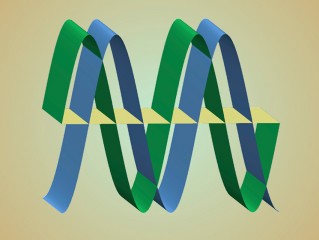Intertwining of Superconductivity and Magnetism

Image courtesy of Brookhaven National Laboratory Schematic image indicating the inferred intertwining of the superconducting wave function (green) with the envelope function (blue) for the atomic magnetism. The amplitudes of both functions oscillate in space to positive and negative values about the zero-amplitude plane (yellow). Note, the maximum of one function occurs where the other passes through zero. The relative shift between the two functions minimizes their overlap.
Inelastic neutron scattering experiments on a copper-oxide superconductor reveal nearly static, spatially modulated magnetism. Because static magnetism and superconductivity do not like to coexist in the same material, the superconducting wave function is also likely modulated in space and phase-shifted to minimize overlap, consistent with recent theory.
The Impact
The new insight regarding the coexistence of superconductivity and atomic magnetism will aid in the development of a predictive theory for high-temperature superconductivity, one that can assist in the design and discovery of new superconductors with improved properties.
Summary
The observation of coexisting magnetism and superconductivity in a particular copper-oxide superconductor suggests that the two types of order can be spatially modulated and intertwined, supporting recent theoretical predictions. Understanding the relationship between superconductivity and a type of atomic magnetic correlation (antiferromagnetism, wherein neighboring atomic spins are oriented in opposite directions) remains a challenge.
The magnetism is associated with the localization of electrons, whereas superconductivity is a state in which electrons are paired and can flow without resistance. Previous experiments have shown that these two states do not like to coexist in the same space. Researchers from Brookhaven National Laboratory characterized slow magnetic fluctuations in a copper-oxide superconductor.
Their discovery shows that the slowly fluctuating magnetism does not disappear in the superconducting state; in fact, it grows stronger at the lowest fluctuation frequencies. The state of intertwined superconductivity and antiferromagnetism that has been proposed by theorists provides a likely explanation of the observations.
These results indicate an intimate connection between superconductivity and magnetism in copper oxides, an important clue for developing a predictive theory of high-temperature superconductivity.
Funding
DOE Office of Science, Basic Energy Sciences including support of the Spallation Neutron Source. The Center for Neutron Research is supported by the National Institute of Standards and Technology and the National Science Foundation.
Publication
Z.J. Xu, C. Stock, S.X. Chi, A.I. Kolesnikov, G.Y. Xu, G.D. Gu, J.M. Tranquada, “Neutron-scattering evidence for a periodically modulated superconducting phase in the underdoped cuprate La1.905Ba0.095CuO4.” Physical Review Letters 113, 177002 (2014). [DOI: 10.1103/PhysRevLett.113.177002]
Contact Information
Kristin Manke
kristin.manke@science.doe.gov
Media Contact
More Information:
http://www.science.doe.govAll latest news from the category: Materials Sciences
Materials management deals with the research, development, manufacturing and processing of raw and industrial materials. Key aspects here are biological and medical issues, which play an increasingly important role in this field.
innovations-report offers in-depth articles related to the development and application of materials and the structure and properties of new materials.
Newest articles

Properties of new materials for microchips
… can now be measured well. Reseachers of Delft University of Technology demonstrated measuring performance properties of ultrathin silicon membranes. Making ever smaller and more powerful chips requires new ultrathin…

Floating solar’s potential
… to support sustainable development by addressing climate, water, and energy goals holistically. A new study published this week in Nature Energy raises the potential for floating solar photovoltaics (FPV)…

Skyrmions move at record speeds
… a step towards the computing of the future. An international research team led by scientists from the CNRS1 has discovered that the magnetic nanobubbles2 known as skyrmions can be…





















